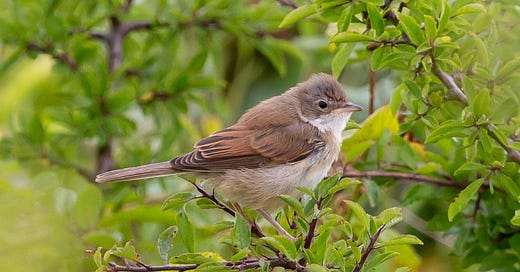The sound of the common whitethroat is one that many of us may associate, consciously or otherwise, with a walk along a country lane or across farmland.
Common whitethroats appear quite suddenly in our hedgerows from mid-April, from which time they make their fast little song tirelessly until well into the summer.
‘Scratchy’ is the word invariably deployed to describe their song, and fits well with the kind of tangled and thorny places you may hear it.
It also has the distinction of being, to my ear, the closest of any British birdsong to the sound of R2D2 in Star Wars (although nowhere near this budgie).
Common whitethroats are not usually shy, and will sit out on top when they sing. Sometimes they will lift off to perform a simple display flight too. You might notice their tiny size & long tail, rufous orange feathers on the wings and, of course, the white throat.
Go for a walk in mid-summer somewhere with plenty of brambles, and you are very likely to come away with several sightings.
The same cannot be said of the lesser whitethroat, which is one of those birds with the superpower of anonymity.
They are superficially similar to the common whitethroat, but with a much darker grey head and a greyer back. These birds like thicker, taller scrub and bigger, older hedgerows, where they are often rather tucked away, much less extrovert that their cousins.
The song is easy to miss too. They have a quiet scratchy warble, often practically inaudible, and a much louder ‘rattle’ made up of one note in a rapid series.
This rattle might easily be dismissed as something else, perhaps a greenfinch or a yellowhammer, especially as it’s often hard to see what’s making the noise.
But once you are tuned in to it it’s amazing how many more lesser whitethroats you may hear.
When I started to become interested in birds I was convinced that lesser whitethroats were terribly rare, until I saw one singing and realised it was the same sound I heard every summer around the allotments in our village.
The lesser is not as widely distributed as the common, but can be found in parts of Wales and southern Scotland, and through most of England.
Give it a try from late April. Find a green lane or scrubby patch and listen out for that rattle. With some luck or patience you may glimpse the rather neat, dark-headed little warbler behind it, and join the relatively small band of people who have knowingly spent time with a lesser whitethroat.
If you would like to get to grips with more common British birds sounds over the next few weeks, you can join the next run of the British Birdsong 101 course from early May. Details will be confirmed in next week’s email, or let me know if you would like to know more in the meantime.
You can join me ‘Up With The Birds’ for a free early morning listen to the nightingales (and other woodland species) via Zoom, on Saturday 24 April. Tickets here.
Media credits:
Thanks to the Birds of Poole Harbour for the recording of the common whitethroat and Fintan O'Brien @fintanobrien for the recording of the lesser whitethroat song.
The image of a lesser whitethroat is by hedara.baltica on Flickr reproduced under Creative Commons licence CC BY-SA 2.0




